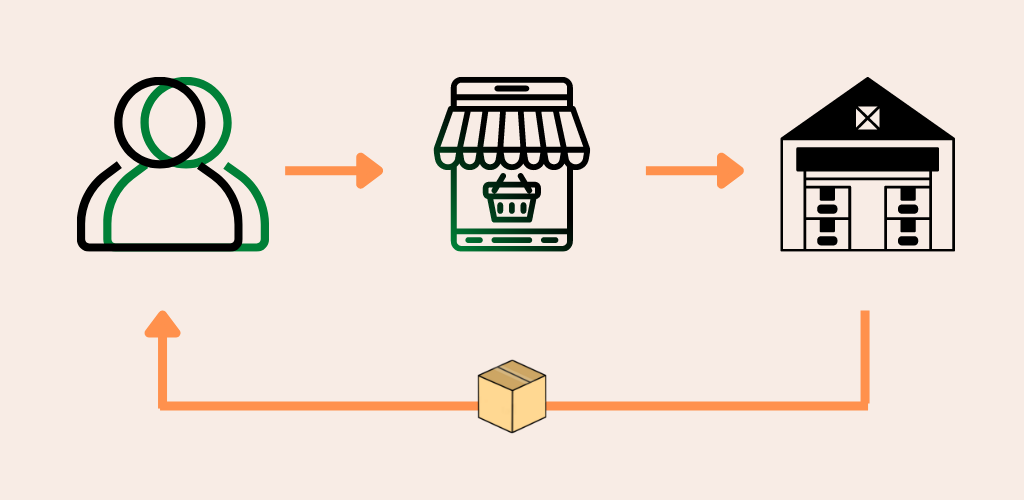What is dropshipping?
Own inventory management or outsource via dropshipping?
For order fulfillment and management of your online business inventory, you have roughly 3 options:
1 - You manage your stock yourself and send orders to customers yourself
2 - You have your own stock, but have it managed by a third party, who also packs and ships the orders for you: We call this 'fulfillment'.
3 - And the most far-reaching solution: You do not have your own stock, but display in your online store the stock of a partner and send orders to this partner. The partner takes the ordered item from his stock and sends it to the customer under your company name: This is called 'dropshipping'.
In this article we will explain the advantages and disadvantages of dropshipping (3) compared to fulfillment (2) and own inventory and order management (1) and of course we will compare the solutions.
Dropshipping compared to fulfillment
What is fulfillment?
With fulfillment, the online business owner enters into an agreement with a logistics service provider and moves his own stock to the warehouse of this company. Unlike with dropshipping, the online business owner remains responsible for the purchase and composition of the stock, just as would be the case with an own warehouse. The big difference is that from this moment on, the online business sends the orders (often via an API) automatically to the fulfillment company. Here the ordered products are then retrieved from the warehouse, packed and shipped to the given delivery address.
The fulfillment company uses your own packing materials and adds your packing slip, so a customer won't know you've outsourced this part of your business process. After shipping, through your link with the fulfillment company, you receive a track & trace that you can share (often also automated) with your customer.
So, in particular, fulfillment saves you a lot of packing and shipping work. And in our experience, fulfillment is not expensive even for small and medium-sized online businesses, because you can take advantage of the lower rates that fulfillment companies have with postal companies such as PostNL. As an indication: From a minimum monthly amount of 75-100 euros, you can usually start considering fulfillment. In many cases, you are even cheaper through a fulfillment company, than if you keep everything in-house (besides, at the post office you can only go until 18:00 and at fulfillment companies your orders are processed until late in the evening, to be delivered the next day).
So if you are buying an online business that manages order fulfillment and inventory in-house, it is definitely an idea to consider fulfillment. We have positive experiences with various fulfillment solutions.
The difference with dropshipping
Dropshipping goes a step further than fulfillment, because in this form of cooperation you also no longer have your own inventory. Your risk (on store dangers and business risks such as fire and theft) is thus greatly reduced, so at first glance this seems like a smart concept. Similar to fulfillment, in the case of dropshipping your online business is linked to your partner's systems, allowing you to display the (current) stock of the dropshipping partner in your online business. Orders that come in, you forward and are handled by the dropshipping partner under your company name, also similar to fulfillment.
In practice, it is often wholesalers who in the past only supplied online businesses in the traditional way and with dropshipping have lowered the threshold for online businesses. In addition to the absence of inventory risk, dropshipping often has a cash flow advantage: You are paid by a customer the moment he or she orders from you with, for example, iDeal, but only afterwards pays the dropshipping partner.
The order process in the case of dropshipping is depicted below:

Making money with dropshipping
Do assume that these advantages translate into a lower margin for the online business owner. Whether dropshipping is an interesting alternative will have to be carefully calculated for each situation. An additional aspect is that your assortment will not be unique when you work with a dropshipping partner, which will have an additional depressing effect on the margin. In practice, for these reasons you will often see that a starting online business uses dropshipping in the initial period and when he knows "how the race is won" he will start buying himself.
There are now about 1000 companies in the Netherlands that offer themselves as dropshipment partners, with some having better processes in place than others. So it pays to research this when you take over an online business and whether this company works on the basis of dropshipping.
Dropshipping via Chinese companies
A recent phenomenon is the cooperation of many small online businesses (often quickly set up based on hosted online business software) with Chinese online businesses/platforms such as AliExpress. The dropshipping principle works the same here: as an online business owner, you maintain customer contact and sales take place via your online business. You pass on the order to the Chinese dropshipping partner. Keep in mind that orders through this construction cannot be delivered within 24 hours, but will take at least 3-7 business days. Depending on which Chinese online business you work with, this can increase even more.
In practice, there are quite a few complaints about these Chinese dropshipping online businesses, so pay close attention to what you adopt. It is just a little more difficult to coordinate with Chinese dropshipment partners than with a Dutch wholesaler that offers a dropshipment solution.
An additional disadvantage is that the Chinese online businesses probably also offer the products you sell in your online business through their own online business. Your customers can of course also see that (provided they know the Chinese online business) and thus quickly find out your margin. In our opinion, this seems to be a model with a relatively short horizon.
Also make sure that the products you sell are safe! As the seller of the non-European products in the Netherlands, you are responsible for the quality of the products your dropshipping partner sends from Asia.
One advantage is that there are hosted online business software providers (such as Shopify) that already offer complete apps that allow you to have an online business filled with the products of a Chinese platform such as AliExpress in a matter of seconds. So in theory it is possible to be 'in business' very quickly.
The advantages and disadvantages of dropshipping
To sum up, dropshipping is a logistical solution that allows you to start an online store without keeping stock yourself and without having to ship the products (or process returns) yourself. We will briefly list the advantages and disadvantages:
Advantages of dropshipping
1. No inventory risk: store defects, poorly selling products but also the risk of fire or theft, these risks are all with the partner.
2. You do not have to organize the handling of orders such as packing, shipping and inventory management. This saves time and possibly personnel costs.
3. No own inventory means you do not have to rent your own warehouse. That definitely cuts costs.
4. No inventory also means that you can do with less working capital (money that is actually "tied up" in your inventory and required to run your business).
5. Normally it takes some time for a store to fine-tune the composition of its assortment. In the case of dropshipping, you can use the knowledge of a partner with years of experience in the industry.
6. It is easy and inexpensive to carry large assortments and thus serve many customers.
Disadvantages of dropshipping
1. Your assortment is almost never unique through this solution. Wholesalers will offer products not only to you but also to other resellers. This puts pressure on the margins you can make.
2. The dropshipping partner is invisible to the customer. As a seller, you are responsible for proper shipping sales as well as product warranty. Here are of course again agreements to make with (Dutch) dropshipping partners, but the reputation damage in case of mistakes lies with you. Active relationship management is therefore recommended.
3. There is a price tag on outsourcing. Everyone in this chain wants to earn a living and especially with a generic and not unique assortment it is not easy to make a healthy margin.
4. Are you working with non-European suppliers? Then keep in mind that you are liable for the products they supply that you actually import into the EU.
5. Not having to manage the inventory yourself also means that you cannot control it. Suppose the dropshipping partner doesn't keep track of inventory properly, you may end up selling products that are subsequently not available for delivery. If this happens more often, it can be extremely frustrating for you as an online business owner (and expensive, too).
Conclusion
Dropshipping is an approachable way to get started in online business. As we have elaborated in this article, there are definitely advantages to it, yet there are also serious disadvantages. In our experience, dropshipping is a great way to start in a market, but it is important after the first few years and with sufficient sales to really look at own inventory management (whether through fulfillment or not) with a unique assortment with less price pressure.
